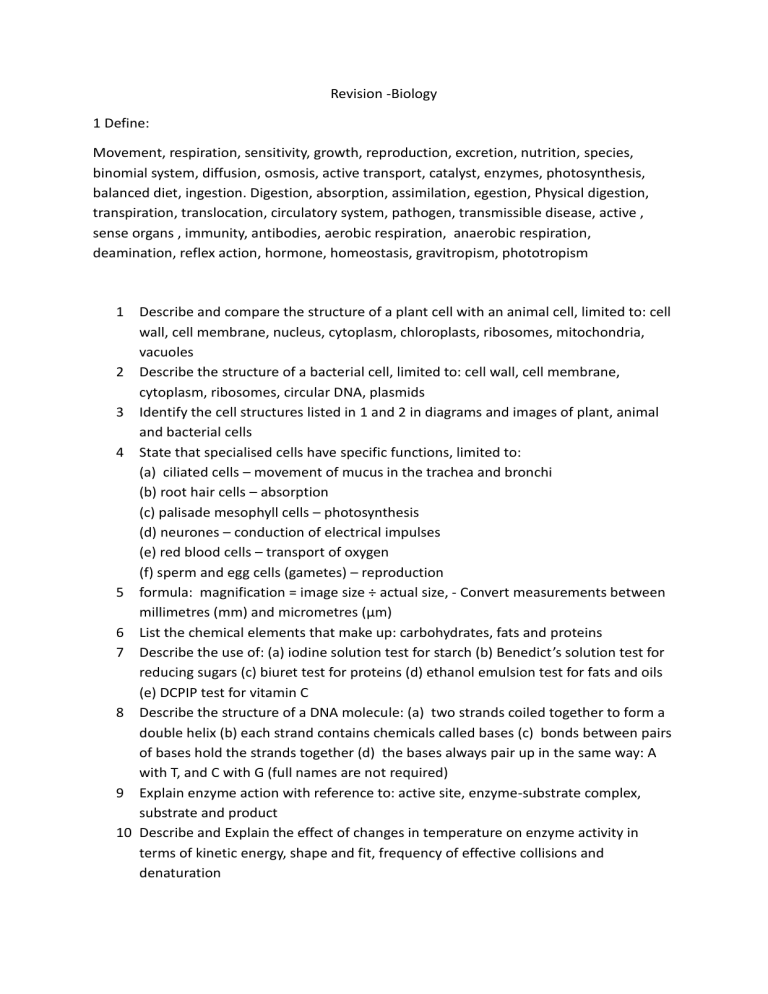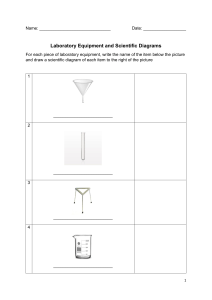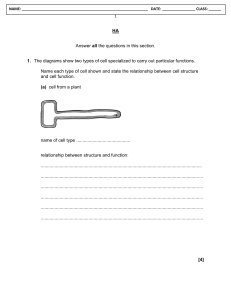
Revision -Biology 1 Define: Movement, respiration, sensitivity, growth, reproduction, excretion, nutrition, species, binomial system, diffusion, osmosis, active transport, catalyst, enzymes, photosynthesis, balanced diet, ingestion. Digestion, absorption, assimilation, egestion, Physical digestion, transpiration, translocation, circulatory system, pathogen, transmissible disease, active , sense organs , immunity, antibodies, aerobic respiration, anaerobic respiration, deamination, reflex action, hormone, homeostasis, gravitropism, phototropism 1 Describe and compare the structure of a plant cell with an animal cell, limited to: cell wall, cell membrane, nucleus, cytoplasm, chloroplasts, ribosomes, mitochondria, vacuoles 2 Describe the structure of a bacterial cell, limited to: cell wall, cell membrane, cytoplasm, ribosomes, circular DNA, plasmids 3 Identify the cell structures listed in 1 and 2 in diagrams and images of plant, animal and bacterial cells 4 State that specialised cells have specific functions, limited to: (a) ciliated cells – movement of mucus in the trachea and bronchi (b) root hair cells – absorption (c) palisade mesophyll cells – photosynthesis (d) neurones – conduction of electrical impulses (e) red blood cells – transport of oxygen (f) sperm and egg cells (gametes) – reproduction 5 formula: magnification = image size ÷ actual size, - Convert measurements between millimetres (mm) and micrometres (μm) 6 List the chemical elements that make up: carbohydrates, fats and proteins 7 Describe the use of: (a) iodine solution test for starch (b) Benedict’s solution test for reducing sugars (c) biuret test for proteins (d) ethanol emulsion test for fats and oils (e) DCPIP test for vitamin C 8 Describe the structure of a DNA molecule: (a) two strands coiled together to form a double helix (b) each strand contains chemicals called bases (c) bonds between pairs of bases hold the strands together (d) the bases always pair up in the same way: A with T, and C with G (full names are not required) 9 Explain enzyme action with reference to: active site, enzyme-substrate complex, substrate and product 10 Describe and Explain the effect of changes in temperature on enzyme activity in terms of kinetic energy, shape and fit, frequency of effective collisions and denaturation 11 Describe and Explain the effect of changes in pH on enzyme activity in terms of shape and fit and denaturation 12 State the word and chemical equation for photosynthesis 13 Describe the structure of human teeth, limited to: enamel, dentine, pulp, nerves, blood vessels and cement, and understand that teeth are embedded in bone and the gums. 14 Describe the functions of the types of human teeth and stomach in physical digestion of food 15 Outline the role of bile in emulsifying fats and oils and explain it’s role 16 Describe the functions of enzymes in digestion- Salivary amylase, Pancreatic amylase, pepsin, Trypsin, Maltase, Lipase 17 Describe the functions of hydrochloric acid in gastric juice 18 Explain the advantages of a double circulation 19 Identify in diagrams and images the structures of the mammalian heart, limited to: muscular wall, septum, left and right ventricles, left and right atria, one-way valves and coronary arteries 20 Identify in diagrams and images the atrioventricular and semilunar valves in the mammalian heart 21 Explain the relative thickness of: (a) the muscle walls of the left and right ventricles (b) the muscle walls of the atria compared to those of the ventricles 22 Explain the importance of the septum in separating oxygenated and deoxygenated blood 10 Describe the functioning of the heart in terms of the contraction of muscles of the atria and ventricles and the action of the valves 23 Describe the structure of arteries, veins and capillaries, limited to: relative thickness of wall, diameter of the lumen and the presence of valves in veins 24 State the functions of capillaries 25 Identify, in diagrams and images, the main blood vessels to and from the liver as: hepatic artery, hepatic veins and hepatic portal vein 26 Identify in diagrams and images the main blood vessels to and from the: (a) heart, limited to: vena cava, aorta, pulmonary artery and pulmonary vein (b) lungs, limited to: pulmonary artery and pulmonary vein (c) kidney, limited to: renal artery and renal vein 27 Identify in diagrams and images the main blood vessels to and from the: (a) heart, limited to: vena cava, aorta, pulmonary artery and pulmonary vein (b) lungs, limited to: pulmonary artery and pulmonary vein (c) kidney, limited to: renal artery and renal vein 28 Identify lymphocytes and phagocytes in photomicrographs and diagrams 29 State the functions of the following components of blood: (a) red blood cells in transporting oxygen, including the role of haemoglobin (b) white blood cells in phagocytosis and antibody production (c) platelets in clotting (details are not 30 31 32 33 34 35 36 37 38 39 40 41 42 43 44 45 46 47 48 49 50 51 52 required) (d) plasma in the transport of blood cells, ions, nutrients, urea, hormones and carbon dioxide State the roles of blood clotting as preventing blood loss and the entry of pathogens Describe the process of clotting as the conversion of fibrinogen to fibrin to form a mesh Outline the process of vaccination: Describe cholera as a disease caused by a bacterium which is transmitted in contaminated water Explain that the cholera bacterium produces a toxin that causes secretion of chloride ions into the small intestine, causing osmotic movement of water into the gut, causing diarrhoea, dehydration and loss of ions from the blood Identify in diagrams and images the following parts of the breathing system: lungs, diaphragm, ribs, intercostal muscles, larynx, trachea, bronchi, bronchioles, alveoli and associated capillaries Explain the role of goblet cells, mucus and ciliated cells in protecting the breathing system from pathogens and particles Describe how oxygen molecules move from the alveoli into the blood. State the word and chemical equation for aerobic respiration State the word and chemical equation for anaerobic respiration in yeast State the word and chemical equation for anaerobic respiration in muscles during vigorous exercise: State that lactic acid builds up in muscles and blood during vigorous exercise causing an oxygen debt Outline how the oxygen debt is removed after exercise, Identify in diagrams and images the structure of the kidney, limited to the cortex and medulla Outline the structure and function of a nephron and its associated blood vessels, Describe the structure of a synapse Describe the events at a synapse as: Identify in diagrams and images the structures of the eye, limited to: cornea, iris, pupil, lens, retina, optic nerve and blind spot Explain accommodation to view near and distant objects in terms of the contraction and relaxation of the ciliary muscles, tension in the suspensory ligaments, shape of the lens and refraction of light Explain the pupil reflex, limited to changes in light intensity and pupil diameter. Explain the pupil reflex in terms of the antagonistic action of circular and radial muscles in the iris Describe the role of adrenaline in the control of metabolic activity, limited to: (a) increasing the blood glucose concentration (b) increasing heart rate Describe the control of blood glucose concentration by the liver and the roles of insulin and glucagon 53 Describe the maintenance of a constant internal body temperature in mammals in terms of: insulation, sweating, shivering and the role of the brain 54 Describe the maintenance of a constant internal body temperature in mammals in terms of vasodilation and vasoconstriction of arterioles supplying skin surface capillaries 55 Explain the role of auxin in controlling shoot growth


